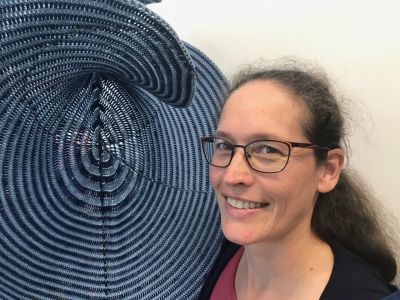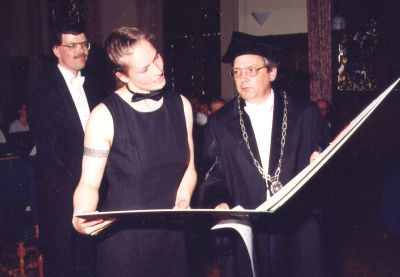‘As a woman scientist, I am fighting against prejudices’

Text: Aafke Eppinga, translation: UVC (RUG)
At the age of 17, Hinke Maria Osinga (1969) moved house to Groningen to pursue a Bachelor’s degree in Mathematics at the University of Groningen. ‘Much too difficult’, according to her father— a mathematics teacher himself . She proved him wrong. She is now employed as Professor of Applied Mathematics at the University of Auckland. Osinga’s career is successful, but she has had to overcome many obstacles to get to where she is today.
Your father thought that mathematics would be too difficult, but that didn’t hold you back. Quite the contrary.
‘That’s right, but I did receive support from my mathematics teacher in secondary school. Despite the fact that I didn’t do as well as I had hoped in my school examination in mathematics, he told me that I “could quite possibly succeed” in a mathematics degree programme. That comment gave me something to hold on to, and it had a major influence on my choice of a degree programme. That is why I invited him to my doctoral defence. After it was over, he came up to me and said, “I told you so!” He had thus remembered it as well.’
How do you look back on your time as a student in Groningen?
‘It was a wonderful time. I lived with my sister and two other housemates on Friesestraatweg. Every other Monday, my friends from secondary school and I would go to the cinema or to the Groningen Symphony Orchestra for five guilders. All other evenings, you could find me on the gymnastics mat. I was still doing high-level gymnastics until shortly before my doctoral defence. In terms of companionship, gymnastics was a good counterpart to my studies, where I was largely surrounded by boys. I formed a study and friendship group with four of them. Many times, we would work out mathematical problems together until deep into the night, accompanied by necessary alcoholic beverages.’
In your studies and in your career, you have often been the first woman in the field. You were the first female member of the mathematics and physics study club
<<W^4?>>
. During your doctoral research, you were the only woman in your department, and you were the first female professor of mathematics in Auckland. I could go on. What influence has that had on your career?
‘I’ve often had to fight—and I sometimes still fight—against assumptions that people make. For example, my supervisor thought that I should not let my career plans get in the way of my boyfriend’s (and future husband’s) career. Moreover, I have almost always not been chosen, at least not first, for the jobs that I have applied for. Many of my publications have been in collaboration with Bernd [Krauskopf, ed.] and, during job interviews, I have often been asked to clarify my contribution to the research. That question is never asked of Bernd. People automatically assume that the greatest insights or most important results have come from him, even though I was also often the one in the lead.’
‘I think that I can say that I have always had to prove myself more than my male colleagues, but that has ultimately made me better and stronger—both as a mathematician and as a person. I’m happy with where I am now and with what I have achieved. And what’s more, I didn’t have to apply for my current position in New Zealand: they created this job for me. That’s nice for a change. Ha-ha!’
Your success is within the grasp of many female scientists. Is that something that you think about?
‘I’m becoming increasingly aware of this. At a conference in Snowbird (Utah, United States) in 2009, a woman came up to me and asked if she could shake my hand. That was the first time that I realized that I could be a role model for other women. At the same time, I don’t consider myself a typical role model who shows that it’s possible to have it all. For example, I don’t have children.’
Did you have a female role model of your own?
‘When I was studying at the University of Groningen, there was only one female professor in the department of mathematics: Ruth Curtain. To me, she was an exceptionally imposing character: she radiated authority. Now I know that she had to act that way in order to be taken seriously as a woman. It is only in retrospect that I realize how important she was for me. That is also why I am calling for more female professors, particularly in the Netherlands. I’ve served on various selection committees, and I’m always disappointed to see how much more quickly female candidates are ruled out than male candidates are. The arguments are always based on facts that have clearly been interpreted differently. If that happens, you can bet that you’ll be hearing from me.’
If you could give a piece of advice to young students at the University of Groningen, what would it be?
‘Take your time! Your student years are the perfect time for seeking out what you want to learn. I graduated exceptionally quickly. Looking back, I wish I had discovered more. And one more thing: consider mathematics. It plays a significant role in all of the major issues that the world is facing right now. This is often underestimated and, as a student, you might not be very aware of it, but it truly is a broadly applicable degree programme that can take you in any direction.’

Hinke Osinga
Hinke Osinga (Dokkum, 1969) grew up in Dokkum. She obtained a masters degree in mathematics in 1991 and a PhD in 1996 from the University of Groningen. Her doctoral dissertation was in the field of mathematics and physics, with specialization in numerical methods for dynamical systems.
In 1996, Osinga joined The Geometry Center in Minneapolis as a postdoc, using visualization and animation for her research. She continued her work as a postdoc at the California Institute of Technology. Following that, she joined the University of Exeter as assistant professor and later the University of Bristol where she got promoted from associate professor to full professor.
Since 2011 she has been Professor of Applied Mathematics at the University of Auckland. She is the first woman in Auckland - and the second in New Zealand - to work as a professor of mathematics.
In 2004 Osinga created a crocheted visualization of the famous Lorenz equation - which describes the nature of chaotic systems - visually insightful. She does this together with her husband (the couple married in 2007) Bernd Krauskopf, who is also a professor of mathematics. Their work received international recognition in 2005 and made Osinga and Krauskopf known to the general public.
Osinga's publications have been awarded with a range of awards, including being invited as a speaker at the prestigious International Congress of Mathematians (Seoul, 2014). She is also the first female mathematician to join the Royal Society Te Apārangi of New Zealand.
